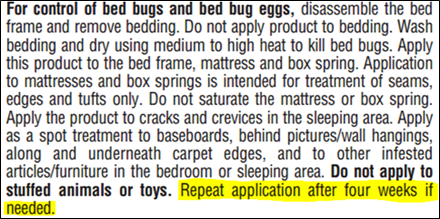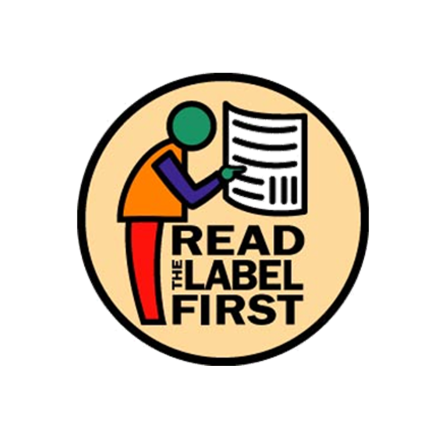USE OF PESTICIDES
Under the Integrated Pest Management strategy, applying pesticides should be conducted only after the previous actions have been conducted. Doing otherwise will likely be ineffective in the long term and could lead to greater expense and even bed bugs developing resistance to various pesticides.
With so many choices on the market its very important that before you purchase any pesticide, be sure to read its label. Ensure that the label states that the pesticide is used to kill/control bed bugs. The label will include a Signal Word, which for home use purposes should be "CAUTION" and state "Keep out of Reach of Children".
The label will also include use, storage, and disposal instructions. Some pesticides are sold in concentrated form and will need to be diluted by adding water prior to use. The label will contain specific instructions on how to do this and how many parts water to add to how many parts of concentrated pesticide. Although more costly per unit, ready to use or pre-diluted pesticide products require no mixing.
Remember, the label is the law and should be read prior to buying the product, prior to using the product, prior to storing the product, and prior to disposing of the product.
"The Pesticide Control Office does not recommend the use of "Fogger" type pesticides for Do-it-Yourself residential bed bug control."
Purchasing a pesticide can be overwhelming. The Environmental Protection Agency (EPA) has registered hundreds of products for use against bed bugs. Most of these can be used by consumers, but a few are registered for use only by specially trained professionals.
These products fall into seven chemical classes of pesticides that are currently registered and widely used for bed bug control. Each chemical class kills bed bugs using a different mode of action. It can be helpful to use pesticides that differ in their mode of action because it can reduce the likelihood that the bugs will develop resistance.
Pyrethrins and Pyrethroids: Pyrethrins and pyrethroids are the most common compounds used to control bed bugs and other indoor pests. Pyrethrins are botanical insecticides derived from chrysanthemum flowers. Pyrethroids are synthetic chemical insecticides that act like pyrethrins. Both compounds are lethal to bed bugs and can flush bed bugs out of their hiding places and kill them. However, where resistant bed bug strains exist, these treatments may cause them to move to a new hiding place or temporarily flush them out of existing locations.
Some bed bug populations have become resistant to pyrethrins and pyrethroids. Sometimes using a combination product (either multiple pyrethroid or pyrethrin active ingredients, or one that combines different chemical classes into the same product) can improve bed bug control. It can also be helpful to switch to an entirely different chemical class to control resistant bed bug populations.
Desiccants: Desiccants work by destroying the waxy, protective outer coating on a bed bug. Once this coating is destroyed, the bed bugs will slowly dehydrate and die. Desiccants are a valuable tool in bed bug control. Because desiccants work through a physical mode of action, the bed bugs cannot become resistant to desiccants as they can to pesticides with other modes of action. In addition, they have a long-lasting effect and don't disturb normal bed bug activities.
Examples of desiccants include:
· Diatomaceous earth.
· Boric acid.

Diatom skeletons found in diatomaceous earth
When using desiccants to control bed bugs use only those that are registered by EPA and labeled for bed bug control. Desiccants that are intended for other uses, such as food-grade or for use in swimming pools, pose an increased inhalation risk to people.
Biochemicals: Cold pressed neem oil is the only biochemical pesticide registered for use against bed bugs. Cold pressed neem oil is pressed directly from seeds of the Neem tree, a tropical evergreen tree found in Southeast Asia and Africa. The oil contains various compounds that have insecticidal and medicinal properties. It is also used in making products including shampoos, toothpaste, soaps, and cosmetics.
Pyrroles: Chlorfenapyr is the only pyrrole pesticide currently registered for use against bed bugs. The compound is a pro-insecticide, i.e. the biological activity depends on its activation to form another chemical. The new chemical disrupts certain functions in the bed bug's cells, causing its death.
Neonicotinoids: Neonicotinoids are synthetic forms of nicotine and act on the nicotinic receptors of the nervous system by causing nerves to fire continually until they fail. Because neonicotinoids use this different mode of action, bed bugs that are resistant to other pesticides will remain susceptible to the neonicotinoid. Imidacloprid is a neonicotinoid commonly found for general use.
Insect growth regulators: Insect growth regulators are chemicals that mimic juvenile growth hormones in insects. They work by either altering the production of chitin (the compound insects use to make their hard external "shell" or exoskeleton) or by altering an insect's development into adulthood. Some growth regulators force the insect to develop too rapidly, while others stop development.
READ THE LABEL CAREFULLY
Each labeled product will have different use instructions.
(Example of label instructions)

Sources:
Michigan Manual for the Prevention and Control of Bed Bugs
United States Environmental Protection Agency


